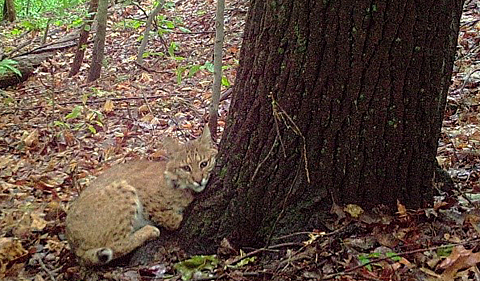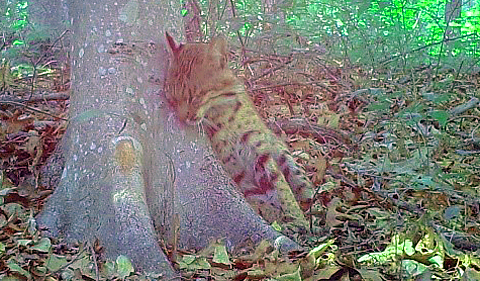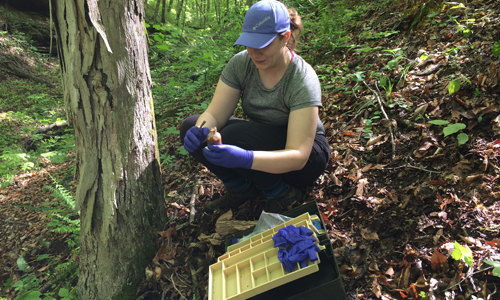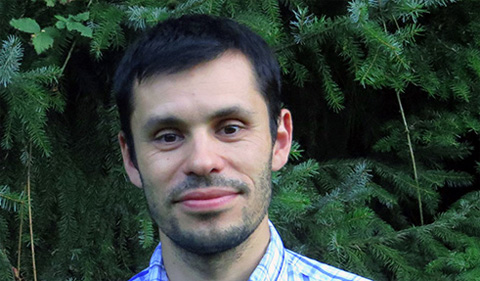
Photo of bobcat taken in Ohio on May 21, 2016.
Go Rufus! Everyone at Ohio University loves Rufus, yet it is amazing how few people realize that bobcats live in our backyards around Athens.
A few weeks ago, Cassie Thompson, master’s student in Dr. Viorel Popescu’s Conservation Ecology Lab, participated in the Majors Fair in Baker Center and showcased a bobcat image captured using remote camera traps in Zaleski State Forest this summer.
Thompson said the undergraduate students “were excited to learn that Bobcats are not just the team they are cheering for, but that there are wild bobcats co-existing with humans in Ohio, and that there is ongoing research about their beloved Rufus at OHIO.”

Ohio bobcat photo taken on June 19, 2016.
‘Chanel #5 for Kitties’ Brings out the Bobcats
“This past summer, in collaboration with Dr. Suzanne Prange, biologist at Ohio’s Division of Wildlife here in Athens, we started gathering baseline data on carnivores in Southeast Ohio, and we were particularly interested in bobcats,” Popescu says. This work was led by Honors Tutorial College student Mackenzie Rich and graduate student Cassie Thompson, with help from many graduate and undergraduate students in Biological Sciences. Mackenzie and her colleagues placed 50 motion-activated trail cameras on Zaleski State Forest and Wayne National Forest, and baited them with a delicious-smelling lure (basically ground skunk anal gland).”
“The reaction of bobcats to the lure was just over the top,” says Rich. “It was so exciting! The lure was like Chanel #5 for kitties; they just loved rubbing their faces in the skunky lure, spent a lot of time just sniffing the base of the tree where we applied the lure, and they just seemed very happy!”

Mackenzie Rich puts remote camera on a tree in the Zaleski State Forest.
Undergraduates Invited to Assist in Lab
“For Rufus-focused work, as well all the other projects mentioned above, we would love to have as much involvement and help from undergraduate students as possible. A lot of the work in the lab starts early in winter and spring, with figuring out a work plan leading to a summer of intensive field research,” says Popescu, who is a core faculty member in the Sustainability Studies theme. “Wildlife and conservation research is fun and rewarding, and requires both commitment and willingness to step outside your comfort zone. A lot of our work involves managing people, not wildlife, as accepting the return of bobcats and black bears in Ohio is more of a social, rather than an ecology matter.”
Bobcats are one of the focus species for research in Popescu’s lab. “As a conservation biologist and wildlife ecologist, the work in my lab aims to provide scientific support to better inform management and conservation decisions across” says Popescu. “My students develop projects driven by the need to provide solutions to current conservation problem. Because of this focus, the research projects are highly applied, and we engage with managers, policymakers and the public to translate science into on-the-ground decisions. We work across many vertebrate species, with the overall goal to quantify the impacts of human activities on wildlife species, and determine proactive steps to stop and prevent further declines.”
Projects in Popescu’s lab span continents, from biodiversity monitoring in China using genetic methods, to brown bear and viper ecology and conservation in Eastern Europe, conservation planning in Canada, and carnivore ecology in Sierra Nevada. Close to home, in Ohio, ongoing graduate projects in Popescu’s lab include an evaluation of roadway impacts on box turtle populations (Marcel Weigand), investigations of climate change impacts on frogs (Thompson), and bobcat ecology and conservation research (Heidi Bencin).
Popescu Lab Gathers Baseline Data on Carnivores in Ohio
So back to bobcats… what’s so special about bobcats, and in particular bobcats in Ohio? Well, bobcats are a species native to Ohio, but they have been extirpated from the state since 1850 due to intensive trapping for fur and loss of forest habitat to farmland.
After a more than a century absence, bobcats have been steadily returning home, and there have been about 200 verified sightings in 2014 alone.
“This is great news for Ohio’s forest ecosystems, which have also recently expanded to Southeast Ohio, but have been lacking a top predator to regulate the food chain,” Popescu says. In addition to bobcats, black bear are slowly coming back, and the Ohio Division of Wildlife has been closely monitoring their return. Now, because bobcats are returning to Ohio, and they are a species that continues to be trapped for fur in many surrounding states (West Virginia and Pennsylvania), there is pressure from Ohio trappers to open a trapping season for the first time in about 150 years.

Dr. Viorel Popescu
“However, we have no clue about how many bobcats are in Ohio, if they are breeding successfully, where they are, or the speed at which they are returning,” he says. “Without such data, opening a trapping season would be detrimental for our bobcats, as numbers could plummet again if we harvest too many animals.
Rich is now in the process of analyzing the data from this summer and determining what kind of habitats bobcats prefer in Southeast Ohio. Graduate student Heidi Bencin will build on this research, and continue to collaborate with Ohio Division of Wildlife to determine what portion of Ohio have the bobcats recolonized, how many bobcats are there, and how roadways, one of the major causes of mortality for bobcats, affect the Ohio population. In addition to trail cameras, Heidi will continue to use the “Chanel #5” lure to attract bobcats and collect hair samples for genetic analyses. All these pieces of information will later be integrated into a major analysis that looks at how well the bobcat population is doing in Ohio. More importantly, this research will inform Ohio Division of Wildlife on the bobcat trapping issue: how many animals can be trapped, and where, to ensure a sustainable population (of course, in case a bobcat trapping season is approved by the Ohio legislature).



















11 Comments